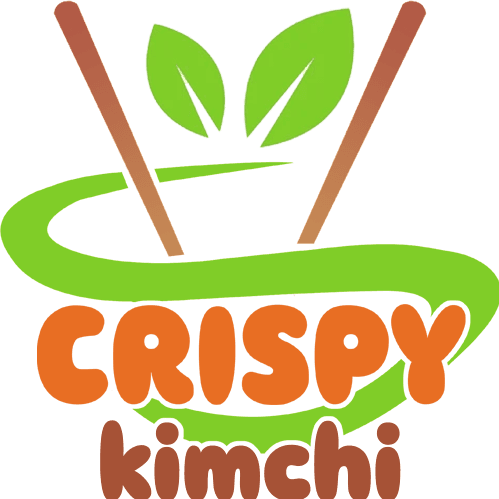Nabak Kimchi: A Crunchy,Refreshing Korean Pickle
Discover the subtle flavors of Nabak Kimchi, a mild and crisp water-based kimchi perfect for those new to Korean cuisine. Learn how to make this traditional pickle at home!
Introduction: Discovering the Delights of Nabak Kimchi
Imagine a kimchi that is not fiery, but rather subtly sweet, refreshing, and delightfully crunchy. This is Nabak Kimchi, also known as “water kimchi” due to its generous use of brine. Unlike the more common, robust cabbage kimchi, often called baechu kimchi, Nabak kimchi presents a milder and more watery experience, which makes it a great entry point to the wonderful world of Korean fermented foods. In addition, it’s often enjoyed during spring and summer for its cooling properties, offering a welcome relief during the warmer months. This article will provide an in-depth look at this unique kimchi, from its origins and flavor profile to a detailed recipe that you can easily follow at home.
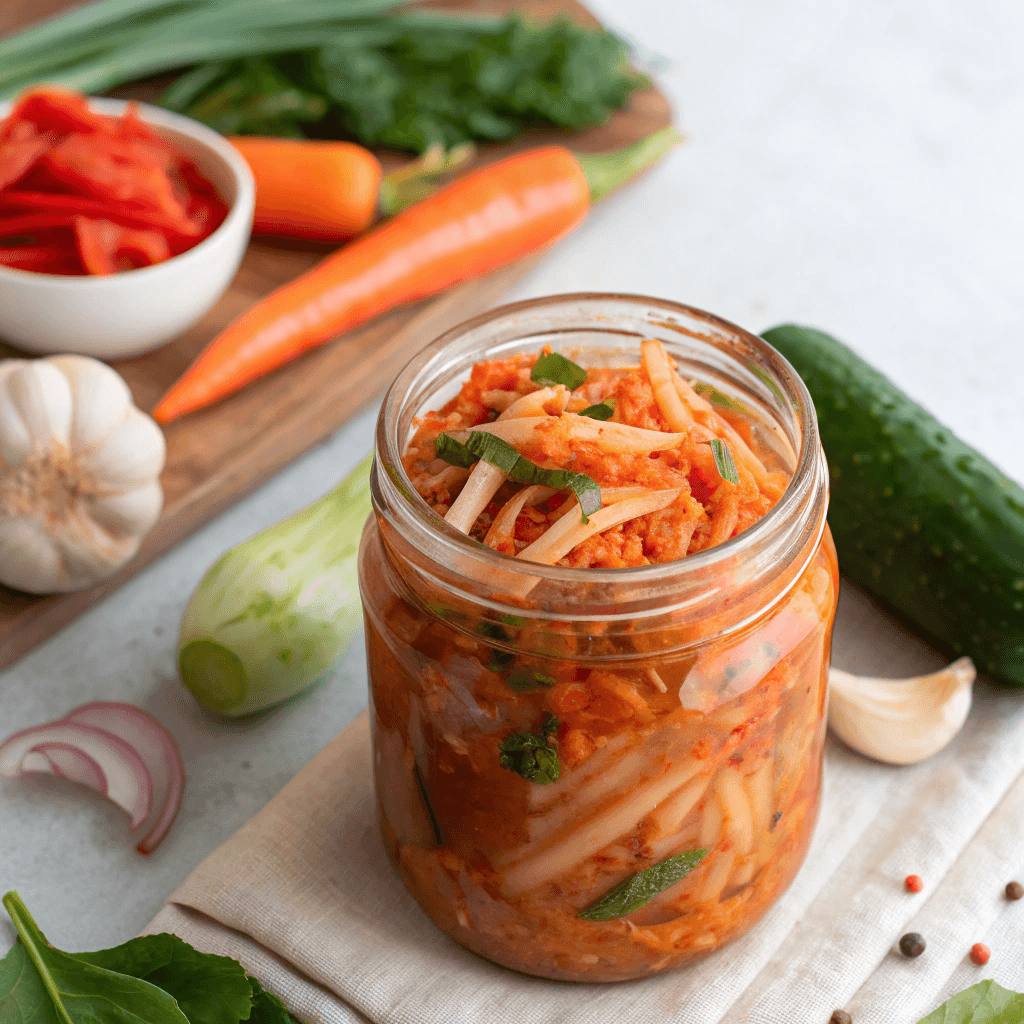
What is Nabak Kimchi? Exploring the Origins and Characteristics
Etymology and Historical Context
The name “Nabak” in Korean refers to the way the vegetables are prepared – sliced or diced into squares or rectangles. This shape is also one of the characteristics that sets it apart from other kimchi. Indeed, Nabak kimchi has deep roots in Korean culinary tradition. It evolved as a unique variation of kimchi, focusing on using a light and refreshing broth, rather than the thick, spicy paste that is found in other kimchi varieties. Therefore, it serves as a gentle introduction to the fermented flavors that are so essential to Korean cooking.
Core Ingredients of Water Kimchi
The core ingredients of Nabak Kimchi are quite simple, yet they combine to create a complex and refreshing flavor. In addition, these ingredients highlight the natural flavors of the vegetables.
- Radish (Korean Radish/Moo): This is the main vegetable in Nabak Kimchi, providing its signature crunch and subtle sweetness.
- Napa Cabbage: Napa cabbage also plays a crucial role, adding a soft contrast to the firm radish.
- Garlic and Ginger: These aromatics provide the necessary depth and slight warmth, essential for the fermentation process.
- Red Pepper Flakes (Gochugaru): While Gochugaru is still used, the quantity is significantly reduced, contributing a mild heat rather than a strong spiciness.
- Brine: The water-based brine is what truly defines Nabak Kimchi, and it is less of a paste and more of a liquid, which creates its distinctive texture.
- Optional Ingredients: Many variations may include other vegetables like carrots, scallions, and even slices of Asian pear or water dropwort (minari). These additions enhance the subtle flavors of the kimchi.
Unique Characteristics
Nabak Kimchi is recognized for its crisp, watery texture, quite different from the denser consistency of many other kimchi varieties. Therefore, the lighter profile makes it easily palatable to a broad audience. The taste is characterized by a mild spice level, and the use of thin slices or dices of vegetables creates an elegant and visually appealing dish. Furthermore, the fermentation process is key to developing its signature tangy and slightly sweet flavor.
Nabak Kimchi vs. Other Kimchi
Compared to baechu kimchi, which is the most popular kimchi made from Napa cabbage, Nabak Kimchi offers a more refreshing experience. Indeed, its water-based brine and lower spiciness level make it a perfect alternative for those who prefer milder flavors. Moreover, the overall approach to making Nabak kimchi, focusing on natural flavors and a light touch with spices, distinguishes it significantly.
The Flavor Profile: Understanding the Taste of Refreshing Kimchi
The flavor of Nabak Kimchi is a symphony of subtle tastes that is both refreshing and satisfying. Therefore, it is not overpowering, but rather nuanced and enjoyable.
Primary Flavors
The primary flavors include savory notes from the vegetables, a hint of sweetness, a tanginess from the fermentation process, and a very mild spiciness. The combination of these flavors creates a well-balanced taste profile. Furthermore, the overall flavor depends on the quality and freshness of the ingredients used.
A Complex Taste
The complexity of Nabak kimchi stems from a few key factors:
- Refreshing Brine: The water-based brine is the base of the flavor, carrying the subtle hints of garlic, ginger, and Gochugaru.
- Subtle Heat: The red pepper flakes add a gentle warmth. Therefore, it is not overwhelming.
- Natural Sweetness: The vegetables and any added fruits impart a natural sweetness, which is key to the overall taste.
Fermentation & Flavor Evolution
As it ferments, the taste of Nabak kimchi evolves from fresh to tangy. This transformation adds depth to the flavor, making it more complex and satisfying over time. Therefore, the fermentation process is crucial to develop its characteristic flavor.
Accessibility & Broad Appeal
The gentle and subtle flavors of Nabak Kimchi make it very accessible to a wide audience. It is a great option, even for those who are not used to the bold flavors of other Korean foods. Indeed, many find this mildness very appealing.
Health Benefits: More than Just a Refreshing Pickle
Nabak kimchi offers not only a delicious taste but also several health benefits. Therefore, incorporating it into your diet can be both enjoyable and beneficial.
Probiotics & Gut Health
Like other fermented foods, Nabak kimchi is rich in probiotics, which are beneficial bacteria that support gut health. Therefore, this can aid in digestion and overall well-being. The fermentation process enriches it with these good bacteria.
Rich in Vitamins and Minerals
The fresh vegetables used in Nabak kimchi are packed with essential vitamins and minerals. Especially radishes and cabbage are known for their high nutrient content. For example, these vitamins and minerals can support overall health and wellness.
Antioxidant Power
It also contains antioxidants, which help protect the body from damage caused by free radicals. Furthermore, the antioxidant content is important for maintaining good health.
Low-Calorie Option
Nabak kimchi is relatively low in calories, which makes it a great choice for those watching their calorie intake. In addition, it’s a satisfying food that doesn’t add excessive calories.
Hydration
The high water content of Nabak kimchi helps to keep you hydrated. Indeed, this is one of its key benefits, especially in warmer months.
Important Disclaimer
While Nabak kimchi is beneficial, it’s important to remember that individual health responses may vary. Always consult with a healthcare professional for personalized dietary advice. Therefore, it is always best to be aware of your body’s unique needs.
Making Nabak Kimchi: A Step-by-Step Recipe
Here’s a detailed recipe to guide you through making Nabak kimchi at home. You will discover that it’s simpler than you might think.
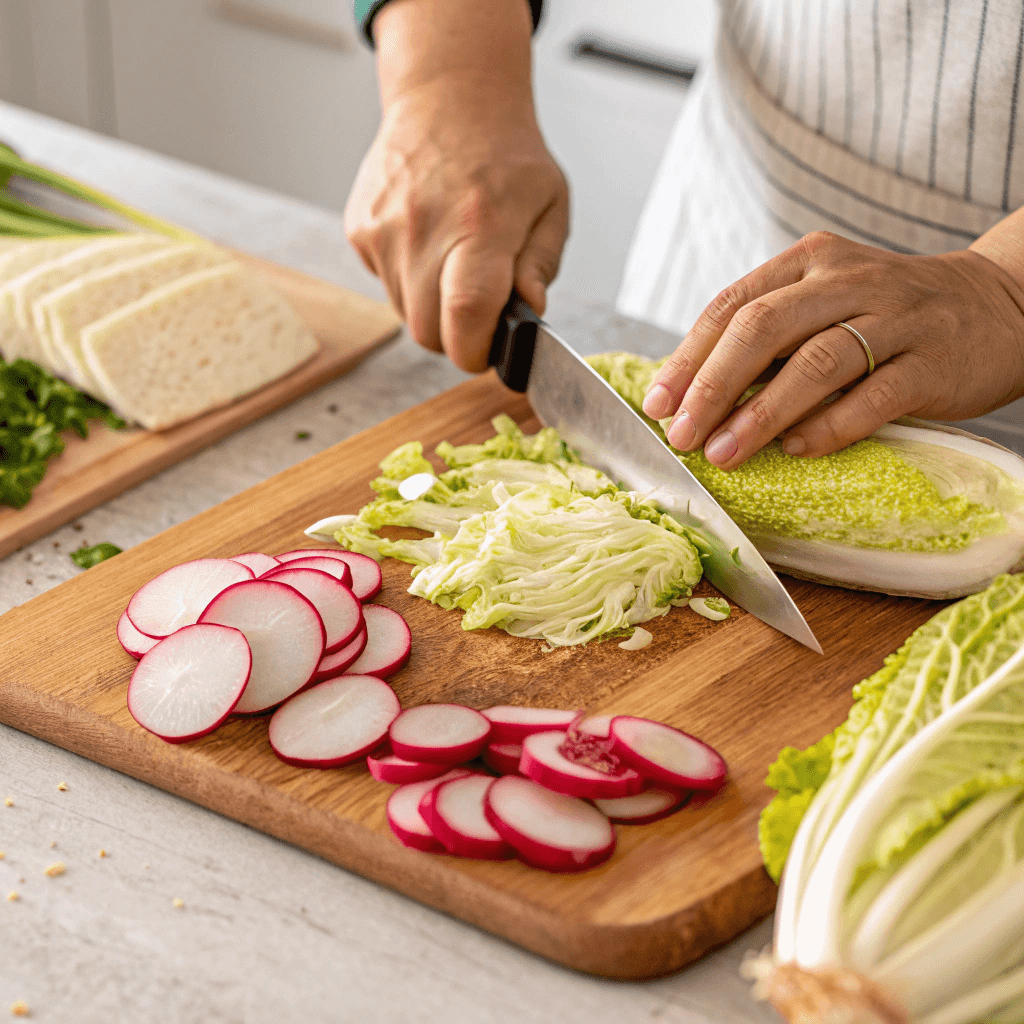
Prep and Equipment
Ingredients:
- 1 medium Korean radish (Moo), about 500g
- 1/2 small Napa cabbage (about 300g)
- 4 cloves garlic, minced
- 1 tablespoon ginger, minced
- 1 to 2 tablespoons Gochugaru (Korean red pepper flakes), adjust to taste
- 1 teaspoon salt
- 1 tablespoon sugar
- 4 cups of filtered water
- Optional: 2-3 scallions, cut into 2-inch pieces
- Optional: 1/4 of an Asian pear, sliced into thin wedges
Equipment:
- Large mixing bowl
- Cutting board
- Sharp knife
- Airtight glass jar or container for fermentation
Detailed Instructions
- Prepare the Vegetables: First, wash the radish and Napa cabbage thoroughly. Peel the radish, then cut it into 1-inch wide, 2-inch-long rectangles. Similarly, cut the Napa cabbage into 1-inch wide, 2-inch-long rectangles. If using, slice the optional carrots and Asian pear thinly.
- Prepare the Brine: In the large bowl, combine 4 cups of water with 1 teaspoon of salt and 1 tablespoon of sugar, and stir until they dissolve completely. Then add the minced garlic, minced ginger, and 1 to 2 tablespoons of Gochugaru. Stir until everything is well mixed.
- Assemble the Kimchi: Gently place the cut radish, cabbage, and any optional vegetables and fruit into the brine mixture. Ensure they are submerged in the liquid. Use a clean spoon or your hand to gently combine them.
- Initial Fermentation: Transfer the mixture to a clean, airtight jar or container. Leave it at room temperature for 1-2 days, depending on the warmth of your environment. You’ll notice some bubbling or slight activity, which is a sign of fermentation.
- Refrigeration: After the initial room temperature fermentation, move the Nabak kimchi to the refrigerator. Therefore, this slows down the fermentation process.
- Serving: It’s best to wait at least 2-3 days in the refrigerator to fully develop the flavors. Therefore, give the kimchi ample time to develop its unique characteristics. Serve it cold directly from the fridge.
Tips for Success
- Fresh Produce: Use only the freshest, high-quality vegetables. They have a direct impact on the final flavor of your kimchi.
- Flavor Balance: Adjust salt, sugar, and spice to your preference. Remember that taste preferences vary.
- Temperature Control: Keep an eye on the fermentation process; if it’s too warm, it might ferment too quickly. Therefore, it’s best to monitor the temperature.
- Experiment: Don’t hesitate to adjust ingredients to suit your own personal taste. For example, some like it more salty, or more sweet.
- Use the Brine: Don’t toss the brine away when serving, use it to enhance the flavor and also when serving or creating other dishes.
Troubleshooting Common Issues
- Over-Fermented: If it tastes too sour, move it to the fridge sooner. In addition, refrigeration can slow down the fermentation.
- Mushy Texture: Avoid overcrowding the jar, make sure the vegetables are fresh, and don’t ferment for too long at room temperature. Furthermore, proper fermentation contributes to a great texture.
- Insufficient Bubbling: This doesn’t necessarily mean it’s not fermenting. Ensure the ingredients are thoroughly submerged in the brine, and you are using good-quality ingredients.
Notes on Variations
Feel free to adjust the level of spice by reducing or adding more Gochugaru. Also, experiment with other seasonal vegetables. In addition, different vegetables can provide different nuances of flavor.
Serving and Pairing Ideas: Enjoying Nabak Kimchi
Nabak kimchi is incredibly versatile and can be enjoyed in various ways, making it a delightful addition to any meal.
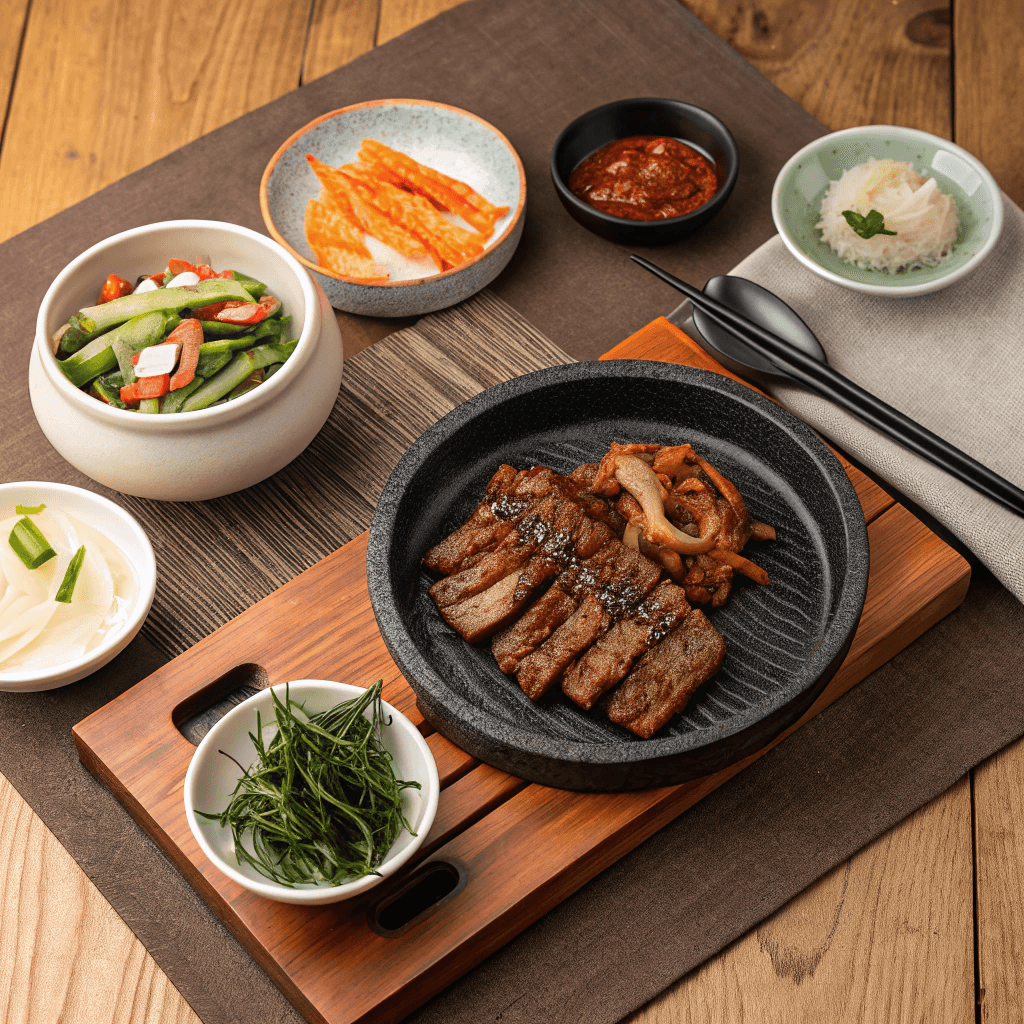
Serving Suggestions
Nabak kimchi is often served as a refreshing side dish or a light appetizer. Therefore, its cooling and refreshing properties make it especially suitable for warmer weather. It’s a great palate cleanser and can be eaten straight from the jar, often served chilled. Moreover, it is delightful with or without the brine, depending on your preference.
Pairing with Korean Dishes
This kimchi pairs perfectly with various Korean dishes. It’s a wonderful complement to BBQ, rice dishes, and noodles. Furthermore, it provides a refreshing contrast to richer foods.
- Korean BBQ: The light tanginess of Nabak kimchi cuts through the richness of grilled meats.
- Bibimbap: Adds a refreshing crunch to the Bibimbap.
- Noodles: Use the brine and the kimchi as a side for your spicy noodles.
Pairing with Non-Korean Foods
Nabak Kimchi also complements many Western dishes.
- Sandwiches and Salads: Add it to salads for a burst of flavor and crunch. Moreover, it’s a fantastic addition to sandwiches.
- Grilled Meats: Serve it alongside grilled chicken or fish as a refreshing side. In addition, it works as a palette cleanser for fatty foods.
- Tacos and Burgers: Use as a garnish on tacos or burgers. Therefore it adds a unique flavor twist.
Creative Uses
- Salad Boost: Mix the kimchi into your salads for an added kick.
- Garnish: Use it as a unique topping for many meals. In addition, the flavors work well with various dishes.
- Brine Dressings: The brine can be used in dressings and marinades for its unique flavor. Furthermore, it’s a great way to reduce food waste.
How to Incorporate it into your everyday meals
It’s very easy to use nabak kimchi as part of your everyday meals. It is very refreshing and adds many flavors that can compliment your meals. Therefore, don’t be afraid to experiment with it to discover new ways of eating it.
Where to Find Nabak Kimchi and Ingredients
Finding Nabak kimchi and its ingredients can be easy, and here’s what to look for.
Local Grocery Stores
Check Asian grocery stores in your area. Many mainstream grocery stores are now expanding their international aisles, so it’s worth checking there too. Furthermore, it’s good to familiarize yourself with your local shops to make the best of what they offer.
Online Retailers
If you do not have access to these in person, there are plenty of reputable online retailers that sell Korean ingredients, and even pre-made Nabak kimchi. Therefore, you’re able to shop from the comfort of your own home.
Availability Notes
Nabak kimchi can be seasonal in some stores. Therefore, it’s always good to call ahead and check to avoid disappointment. However, the key ingredients are always available year-round.
Ingredient Substitutions
If you cannot find the specific ingredients, don’t worry. For example, you can use daikon radish if you cannot find Korean radish. In addition, there are a few substitutes if you are unable to locate the specific ingredients.
Tips for Selecting Ingredients
Select the freshest, firmest vegetables you can find. This ensures you are starting with quality ingredients.
Conclusion: A Gentle Introduction to Korean Fermented Goodness
Nabak kimchi is a delightful and refreshing type of kimchi that offers a gentle introduction to the world of Korean fermentation. In addition, its unique flavor and texture make it an excellent option for those who may not be familiar with spicier varieties. Its crispness, tanginess, and subtle sweetness create a balanced flavor that’s incredibly versatile and easy to enjoy. Therefore, we hope you’re encouraged to try making this at home. Nabak kimchi is sure to become a favorite in your kitchen.
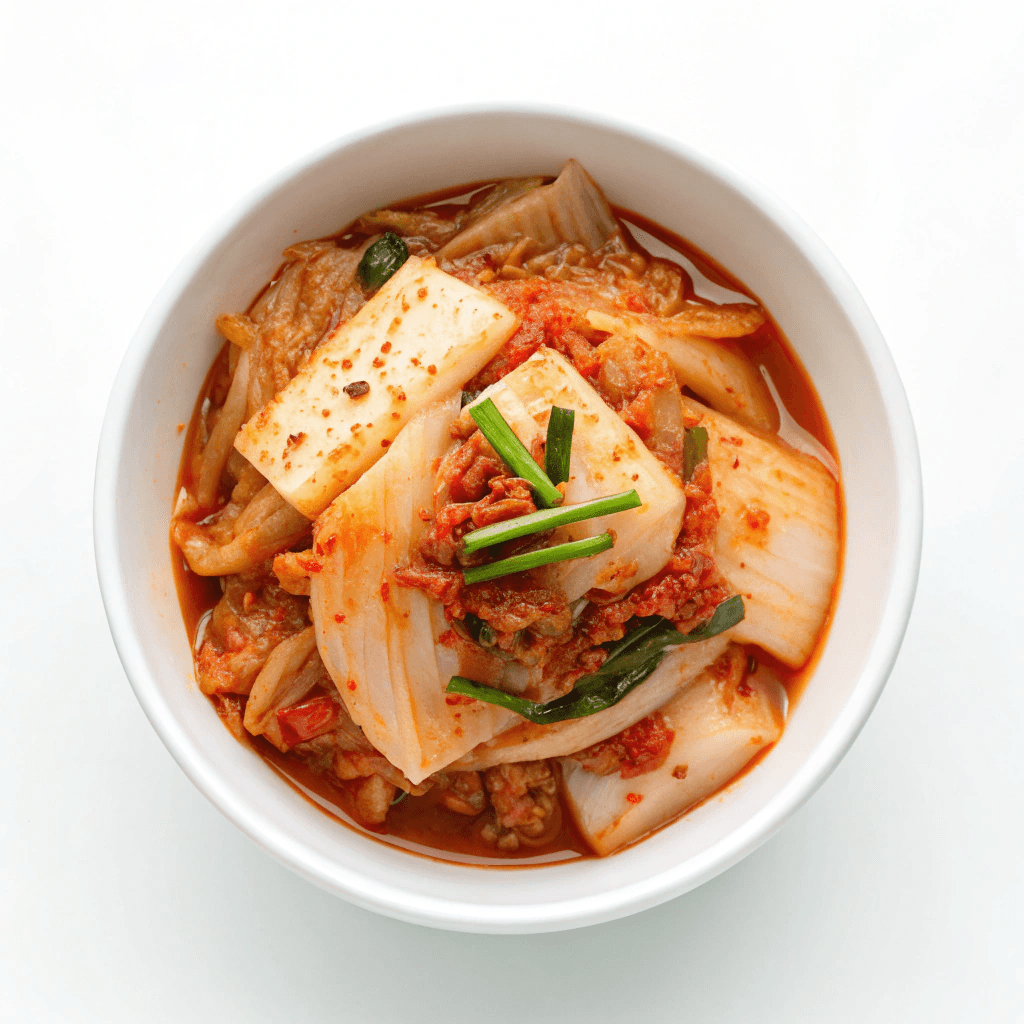
Frequently Asked Questions (FAQ)
Is Nabak kimchi fermented?
Yes, Nabak kimchi is fermented. The fermentation process is what gives it its distinct tangy flavor and probiotic benefits. It is created by adding salt to the mixture and leaving it at room temperature, then in the fridge.
What is the difference between Nabak and Dongchimi kimchi?
While both are types of water-based kimchi, Nabak kimchi generally contains more vegetables that are cut into large rectangles, uses red pepper flakes, and has a more vibrant color. On the other hand, Dongchimi kimchi is often lighter in color, contains whole vegetables, and is known for its clearer, milder brine, usually without red pepper flakes.
What is special about kimchi?
Kimchi is special because it is a staple in Korean cuisine and also is a delicious way to incorporate fermented food into the diet. It is known for its complex flavor, which is a combination of tangy, sour, spicy, and savory notes. Additionally, it’s rich in probiotics, vitamins, and antioxidants, and therefore is a very healthy and nutritious food.
Why is my kimchi not bubbling?
Kimchi bubbles because it is a sign of the fermentation process, and this bubbling is not always necessary. If your kimchi is not bubbling, it could be due to a variety of factors including temperature, salt levels, or ingredient quality. Don’t worry, as long as it is developing a tangy flavor and is kept in an airtight container, it is still fermenting.
if you’re eager to delve deeper into the world of Korean cuisine and fermentation, there are several excellent resources available online. For a broader understanding of kimchi varieties and their significance in Korean culture, websites like the Korean Tourism Organization offer valuable insights. Additionally, you can explore resources on fermentation processes and their health benefits by visiting sites like Healthline or WebMD, which provide reliable and evidence-based information. Furthermore, if you are looking to buy authentic ingredients, check out sites like Hmart, a great place to find Korean specialty foods. These sites offer comprehensive information to enhance your understanding of Nabak Kimchi and its place in Korean gastronomy.
check more of our recipes like :
Korean Sanjeok: Skewers of Flavor

